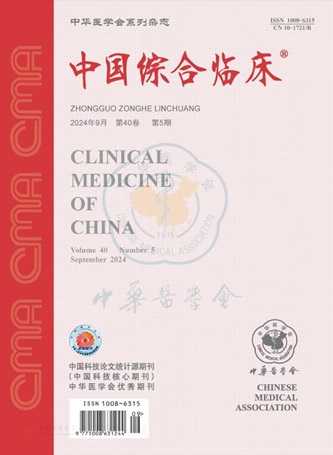阿帕替尼联合S-1一线治疗晚期非小细胞肺癌的疗效观察
引用次数: 0
摘要
目的探讨阿帕替尼联合S-1治疗无敏感基因突变或未知突变状态的晚期非小细胞肺癌的疗效和安全性。方法选择河北省秦皇岛市第一医院肿瘤科2015年4月至2017年4月收治的104例无敏感基因突变或未知突变状态的晚期NSCLC患者,均拒绝静脉化疗。采用1:1数字法将104例患者随机分为治疗组(阿帕替尼联合S-1组)和对照组(S-1单独组)。然而,治疗组中有两名患者因个人原因转入对照组。阿帕替尼联合S-1组50例,S-1组54例。对两组患者的疗效及不良反应进行评价。结果客观缓解率分别为48.0%(24/50)和27.8%(15/54)(χ2=4.530,P=0.033),疾病控制率分别为82.0%(41/50)和74.1%(40/54)(σ2=0.947,P=0.031),PFS中位数分别为6.6个月和3.4个月(t=25.555,P=0.000),OS中位数分别为16.0个月和10.5个月(t=59.439,P=0.000。不良反应总发生率分别为82.0%(41/50)和70.4%(38/54)(χ2=1.923,P=0.166),其中18.0%(9/50)和13.0%(7/54)高于3级(χ2=0.506,P=0.477)。结论阿巴替尼联合S-1胶囊治疗无基因突变或未知突变的晚期癌症具有良好的近期和远期疗效。不良反应可耐受,可作为不愿接受静脉化疗的患者的一线治疗。关键词:非小细胞肺癌;阿法替尼;S-1胶囊本文章由计算机程序翻译,如有差异,请以英文原文为准。
Observation on the effect of apatinib combined with S-1 as first-line treatment of advanced non-small cell lung cancer
Objective
To explore the efficacy and safety of apatinib combined with S-1 in patients with advanced NSCLC without sensitive gene mutation or unknown mutation status.
Methods
One hundred and four patients with advanced NSCLC without sensitive gene mutation or unknown mutation status were selected from the oncology department of the First Hospital of Qinhuangdao City, Hebei Province from April 2015 to April 2017.All patients refused intravenous chemotherapy.One hundred and four patients were randomly divided into treatment group (apatinib combined with S-1 group) and control group (S-1 alone group) by 1: 1 digital method.However, two patients in the treatment group transferred to the control group for personal reasons.There is 50 cases in apatinib combined with S-1 group and 54 cases in S-1 group.The efficacy and adverse reactions of the two groups were evaluated.
Results
The objective remission rate was 48.0% (24/50) and 27.8% (15/54) (χ2=4.530, P=0.033), the disease control rate was 82.0% (41/50) and 74.1% (40/54) (χ2=0.947, P=0.331), the median PFS was 6.6 months and 3.4 months (t=25.555, P=0.000), the median OS was 16.0 months and 10.5 months (t=59.439, P=0.000), respectively.The overall incidence of adverse reactions was 82.0% (41/50) and 70.4% (38/54) respectively (χ2=1.923, P=0.166), of which 18.0% (9/50) and 13.0% (7/54) were more than grade 3 respectively (χ2=0.506, P=0.477). There was no death caused by treatment-related adverse reactions in both groups.
Conclusion
Appatinib combined with S-1 capsule has good short-term and long-term efficacy in the treatment of advanced non-small cell lung cancer without gene mutation or unknown mutation.The adverse reactions are tolerable and can be used as first-line treatment for patients unwilling to receive intravenous chemotherapy.
Key words:
Non-small cell lung cancer; Apatinib; S-1 capsules
求助全文
通过发布文献求助,成功后即可免费获取论文全文。
去求助
来源期刊
CiteScore
0.10
自引率
0.00%
发文量
16855
期刊介绍:
Clinical Medicine of China is an academic journal organized by the Chinese Medical Association (CMA), which mainly publishes original research papers, reviews and commentaries in the field.
Clinical Medicine of China is a source journal of Peking University (2000 and 2004 editions), a core journal of Chinese science and technology, an academic journal of RCCSE China Core (Extended Edition), and has been published in Chemical Abstracts of the United States (CA), Abstracts Journal of Russia (AJ), Chinese Core Journals (Selection) Database, Chinese Science and Technology Materials Directory, Wanfang Database, China Academic Journal Database, JST Japan Science and Technology Agency Database (Japanese) (2018) and other databases.

 求助内容:
求助内容: 应助结果提醒方式:
应助结果提醒方式:


